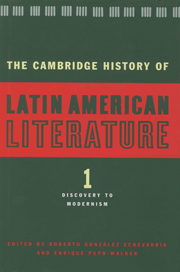Book contents
- Frontmatter
- Introduction to Volume 1
- 1 A brief history of the history of Spanish American Literature
- 2 Cultures in contact: Mesoamerica, the Andes, and the European written tradition
- 3 The first fifty years of Hispanic New World historiography: the Caribbean, Mexico, and Central America
- 4 Historians of the conquest and colonization of the New World: 1550–1620
- 5 Historians of the colonial period: 1620–1700
- 6 Colonial lyric
- 7 Epic poetry
- 8 Spanish American theatre of the colonial period
- 9 Viceregal culture
- 10 The eighteenth century: narrative forms, scholarship, and learning
- 11 Lyric poetry of the eighteenth and nineteenth centuries
- 12 Spanish American theatre of the eighteenth century
- 13 The nineteenth-century Spanish American novel
- 14 The brief narrative in Spanish America: 1835–1915
- 15 The Spanish American theatre of the nineteenth century
- 16 The essay in Spanish South America: 1800 to Modernismo
- 17 The essay of nineteenth-century Mexico, Central America, and the Caribbean
- 18 The gaucho genre
- Index
- Bibliographies
- References
10 - The eighteenth century: narrative forms, scholarship, and learning
Published online by Cambridge University Press: 28 March 2008
- Frontmatter
- Introduction to Volume 1
- 1 A brief history of the history of Spanish American Literature
- 2 Cultures in contact: Mesoamerica, the Andes, and the European written tradition
- 3 The first fifty years of Hispanic New World historiography: the Caribbean, Mexico, and Central America
- 4 Historians of the conquest and colonization of the New World: 1550–1620
- 5 Historians of the colonial period: 1620–1700
- 6 Colonial lyric
- 7 Epic poetry
- 8 Spanish American theatre of the colonial period
- 9 Viceregal culture
- 10 The eighteenth century: narrative forms, scholarship, and learning
- 11 Lyric poetry of the eighteenth and nineteenth centuries
- 12 Spanish American theatre of the eighteenth century
- 13 The nineteenth-century Spanish American novel
- 14 The brief narrative in Spanish America: 1835–1915
- 15 The Spanish American theatre of the nineteenth century
- 16 The essay in Spanish South America: 1800 to Modernismo
- 17 The essay of nineteenth-century Mexico, Central America, and the Caribbean
- 18 The gaucho genre
- Index
- Bibliographies
- References
Summary
Introduction
In the year 1737, as an epidemic raged in and around Mexico City, its inhabitants carried out desperate acts of devotion to a number of holy images in a series of unsuccessful attempts to halt the disease’s mortal progression. Finally, after the city formally declared the Virgin of Guadalupe as its official patron, the epidemic subsided. Recounting this miraculous turn of events in his four-volume Historia de la Provincia de la Compañía de Jesús de Nueva España (1767; Mexico, 1841–1842), Francisco Javier Alegre (1729–1788), a Jesuit himself and the acclaimed historian of the Order, observed that it appeared the exterminating angel was only waiting for the declaration of patronage in order to sheath his sword (Lafaye, Quetzalcóatl and Guadalupe 86; see also Deck, Francisco Javier Alegre). Jacques Lafaye points to this moment as the occasion for the “belated flowering for the Guadalupe cult,” two centuries after its apparition, a flowering he relates to incipient Mexican national consciousness and, more generally, to a period of creole triumphalism in the early 1700s. Even discounting these later developments, Alegre’s account preserves for us a striking example of colonial hagiolatry.
Almost half a century later, in 1779, a smallpox epidemic was declared in Mexico City. Dr. José Ignacio Bartolache (1739–1790), who had edited the Mercurio Volante (which some consider to be America’s first medical journal) during its brief appearance from 1772 to 1773, presented to the viceroy a plan for combatting the disease. Although Bartolache’s text has unfortunately been lost, his recommendations were preserved in the Cabildo’s official approval of the plan.
- Type
- Chapter
- Information
- The Cambridge History of Latin American Literature , pp. 336 - 374Publisher: Cambridge University PressPrint publication year: 1996
References
- 3
- Cited by

